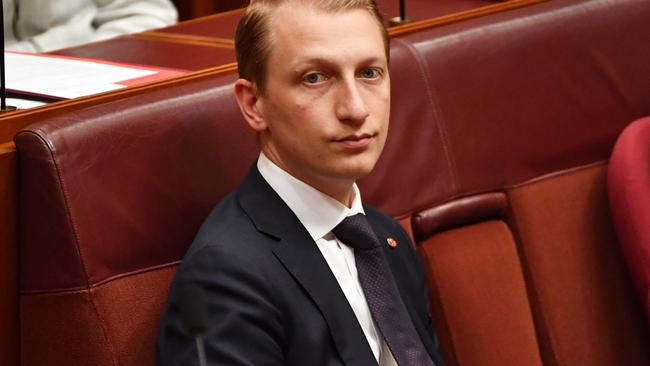Universities cry poor but spend big on advertising
Australia’s universities spent $1.7bn on advertising, marketing and promotions over the past seven years | GRAPHIC

The nation’s universities have spent $1.7 billion on advertising, marketing and promotions over the past seven years as the tertiary sector shifted to a demand-driven system.
As universities run a fierce campaign against higher education reforms that would impose efficiency dividends on the sector, it can be revealed they spent $300 million on campaigns, slogans and sponsorship last year while competing for domestic and international students, staff and research partners. The spending was $30m more than in 2015, an increase of 11 per cent.
The Coalition is pressing ahead with its third attempt to achieve the conservative holy grail of university reform. Liberal senator James Paterson said he was “pretty sceptical about the value to taxpayers of government-funded, not-for-profit universities spending up big on marketing to attract students’’.
He said this was “particularly so when many of those marketing activities were not about the substance of what the universities offered but resembled gimmicks and irrelevant sponsorships’’.
As the Turnbull government continues to prosecute its argument that universities have benefited from “rivers of gold’’, it is struggling to secure the numbers it needs in the Senate for its reforms in the face of opposition from Labor and the Greens.
Liberal Democrat senator David Leyonhjelm, who holds one of the 10 out of 12 crossbench votes the government must lock in, said he believed universities had their “hypocrisy on display’’.
“They are pleading hardship and yet they pay their vice-chancellors and senior managers massive salaries, while all the government is proposing is to reduce from 58 to 54 per cent its subsidy of student courses,’’ Senator Leyonhjelm said. “Students will continue to pay nothing upfront. And yet, like Chicken Little, they are arguing the sky is going to fall. When the vice-chancellors and senior managers reduce their own inflated salaries, I’ll start taking their claims of hardship a bit more seriously.”
Universities argue the government’s changes represent the most significant overhaul in the sector for two decades and will result in a “double hit’’ on students paying more for a lower-quality education and staff cuts, jeopardising Australia’s $22bn-a-year education export industry.
The government disputes this, declaring the overhaul is necessary because the demand-driven system needs to be sustainable for future generations. The $2.7bn tertiary overhaul introduces a 2.5 per cent efficiency dividend on universities next year and in 2019, ties about $500m a year in university funding to performance improvements, and requires graduates to begin paying back their HELP debt at 1 per cent when their income reaches $42,000. It was the largest savings measure in the May budget.
The Weekend Australian revealed last month the nation’s 38 public university vice-chancellors were paid an average salary package of $890,000 last year, with 11 earning more than $1m.
Under the previous Labor government, universities began shifting to a demand-driven system from 2010 when they were allowed more flexibility in enrolling over their quotas of students.
From 2010 to 2016, all universities spent a combined total of $1.7bn on marketing.
In 2012, university places were uncapped, which allowed institutions to enrol unlimited numbers of students in commonwealth-supported bachelor-degree places, expect in medicine.
Last year, Sydney’s Macquarie University spent $11.3m on advertising, promotions and marketing according to its annual report, up $4.4m from 2015. The University of New England in Armidale, NSW, outlaid $12.1m, up $4.2m and Melbourne’s Deakin University spent an extra $5.8m bringing its total last year to $20.3m.
Other universities tightened their belt, including the University of Western Australia, which reduced its advertising budget by $3.5m to $6.3m.
A UWA spokesman said the university had refreshed its brand in 2015, which partly accounted for the difference, but he added that the university had been addressing expenditure “for some time and will continue to strive to introduce efficiencies to improve our financial performance’’.
“All universities, including UWA, will increasingly rely on income from fee-paying students as other sources of revenue, such as government funding, are restricted,” the spokesman said
Universities Australia chief executive Belinda Robinson said the attacks on tertiary advertising budgets were a “pretty naked attempt to distract attention from the biggest cuts to university funding in 20 years — and it’s deeply misleading’’.
“Our universities spend less than 1 per cent of their budgets on all marketing activities — a percentage that has not changed since 2012 — and some of that money includes activities to enhance the student experience,” she said. “Let’s not forget the enormous size of the proposed cuts — it would be another hit of $2.8bn from universities and their students, on top of cuts of almost $4bn since 2011.’’
Education Minister Simon Birmingham defended the government’s reform plan, saying it “delivers a slightly lower but more sustainable rate of funding growth for universities of 23 per cent over the next four years’’.



To join the conversation, please log in. Don't have an account? Register
Join the conversation, you are commenting as Logout